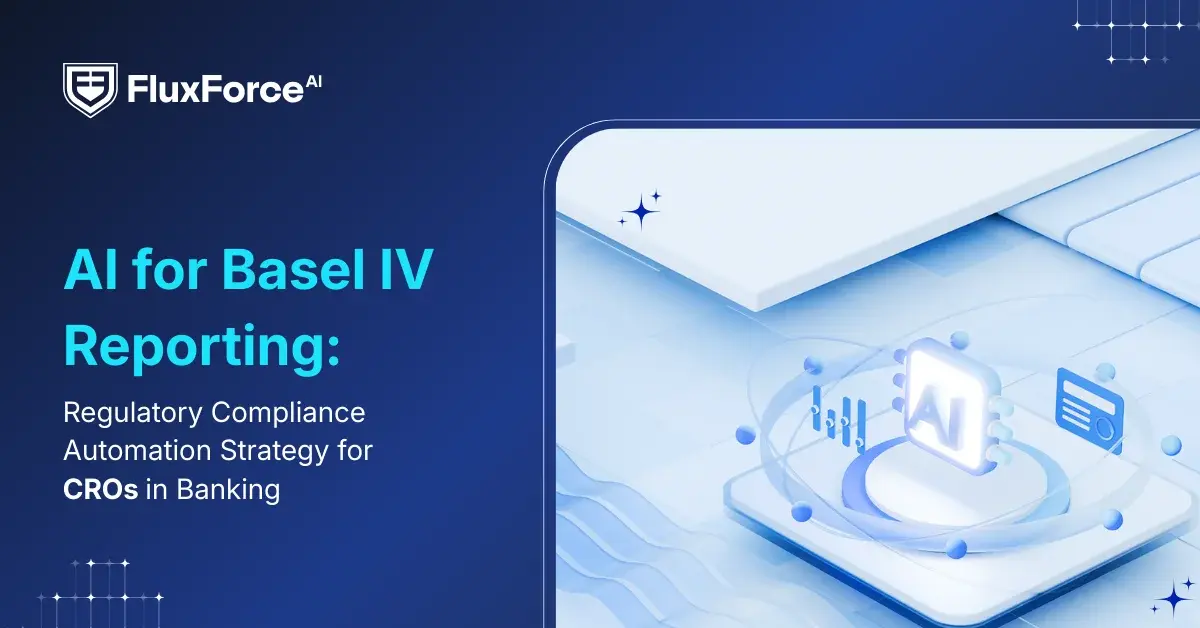Listen To Our Podcast🎧

Introduction
Regulated industries are often burdened with compliance fatigue. To manage regulatory demands, organizations often face a critical choice between manual compliance and automated approaches.
Manual methods offer control and familiarity but carry risks of inefficiency and error. AI-powered compliance automation, on the other hand, introduces speed and consistency, but is expensive.
This article explores the comparison between manual and automated compliance, highlighting pros, cons, and best practices to help decision-makers evaluate the right path for effective compliance management.
Manual Compliance Monitoring in Finance
The manual approach to compliance management involves human-led oversight of transactions, documentation, and reporting activities. It is document-intensive and often requires compliance officers to align banking operations with regulatory standards using spreadsheets and manual checks.
Despite its resource demands, manual monitoring remains a structured practice within smaller financial institutions to manage regulatory obligations and maintain adherence to established frameworks.
Pros and Cons of Manual Compliance
Manual compliance offers the advantage of structured oversight but comes with limitations in accuracy, scalability, and regulatory efficiency.
Pros- Direct Oversight: Manual processes provide compliance officers with full visibility and control over individual transactions and reporting cycles.
- Audit Readiness: Manual recordkeeping ensures traceable documentation, which regulators still recognize as a reliable audit evidence format. Manual compliance offers the advantage of structured oversight but comes with limitations in accuracy, scalability, and regulatory efficiency.
Cons
- High Error Rates: Studies show manual compliance monitoring results in error rates up to 21% compared to 2% in automated processes.
- Scalability Limits: Financial institutions processing over 10,000 daily transactions struggle to scale manual monitoring without major staffing costs.
- Regulatory Risk: Delayed manual checks increase the probability of missed red flags, leading to higher exposure to penalties and compliance breaches.
Automated Regulatory Compliance in Finance
Regulatory compliance automation in finance integrates Artificial Intelligence, rule-based engines, and monitoring systems to automatically manage transactions, reporting, and documentation against regulatory frameworks.
Automation technologies are capable of handling evolving standards, maintaining real-time oversight, and strengthening risk management. This approach allows financial organizations to align operations with regulatory obligations consistently and at scale across complex compliance environments.
Key Compliance Automation Tools in Banking Environments
1. Machine Learning Analytics Engines
These engines leverage advanced algorithms to analyse transaction patterns, customer behaviour, and risk indicators. By continuously learning from historical data, they improve anomaly detection and help institutions proactively address emerging risks.
2. Real-Time Transaction Monitoring Systems
Automated platforms screen transactions instantly against predefined rules and regulatory requirements. Suspicious activities are flagged in real time, reducing reliance on manual review and minimizing the risk of delayed intervention.
3. Regulatory Reporting Automation Platforms
These solutions compile, format, and submit regulatory reports automatically, ensuring accuracy and consistency while significantly reducing the time and effort associated with manual report preparation.
4. Risk Assessment and Scoring Tools
By evaluating customer profiles, transaction histories, and market data, these tools assign risk scores and trigger compliance actions based on defined thresholds, enabling informed, data-driven decision-making.
5. Document Management and Audit Trail Systems
Digital platforms systematically organize compliance records and maintain comprehensive audit trails, ensuring regulatory requirements are met while enhancing transparency and simplifying internal or external audits.
Onboard Customers in Seconds

Benefits of AI in Compliance Monitoring

- Real-Time Detection: AI enables continuous monitoring of transactions, identifying suspicious activity instantly and reducing average detection time by over 80% compared to traditional methods.
- Error Reduction: AI-driven compliance systems lower monitoring errors to less than 2%, compared to the 15–20% error margin in human-led compliance checks.
- Scalable Oversight: AI expands compliance capacity without proportional staffing increases. By processing millions of transactions daily, it allows institutions to sustain efficiency under rising regulatory pressure.
- Predictive Insights: Machine learning models forecast compliance risks by analysing historical patterns, helping financial institutions anticipate regulatory breaches before they occur.
- Audit Efficiency: AI generates well-formatted, audit-ready reports, cutting preparation time by up to 60%, improving transparency, and supporting faster regulator engagement.
Challenges in Automating Compliance in Finance
Automating compliance in financial institutions is not only a technology initiative but an operational transformation. Firms must coordinate across IT, risk, and compliance teams to prevent disruptions and ensure regulatory accuracy.

Implementation Complexity: Deploying automated compliance systems involves integrating multiple banking platforms, which can challenge alignment with legacy infrastructure.
Operational Dependence: Automation increases reliance on technology vendors and system uptime, exposing institutions to potential disruptions or integration failures.
Change Management: Shifting from manual processes demands workforce adaptation, retraining, and realignment of compliance responsibilities.
Regulatory Alignment: Frequent regulatory updates require ongoing system recalibration to ensure compliance standards are met.
Cost Barriers: Initial investment in AI platforms, infrastructure upgrades, and staff training can strain budgets, particularly for mid-sized institutions.

Shaping the Future of AI in Finance
Fluxforce research uncovers how banks and enterprises are adapting to fraud, compliance, and data challenges in 2025.
Manual Compliance vs. AI Compliance Automation: The Better Future
Choosing between manual compliance and AI-driven automation shapes the future of financial operations. The following table highlights key differentiators, helping institutions evaluate efficiency, risk management, scalability, and long-term compliance strategy.
|
Aspect |
Manual Compliance |
AI Compliance Automation |
|
Accuracy & Error Rates |
Human review is prone to mistakes; studies show up to 18–20% transaction errors in complex reporting |
AI continuously learns from patterns, reducing errors to 2–3% and improving anomaly detection accuracy |
|
Processing Speed |
Batch reviews and manual reporting can take days, delaying risk mitigation |
Processes thousands of transactions in real time, generating instant alerts for suspicious activities |
|
Resource Allocation |
High dependency on skilled compliance staff; scaling requires proportional hiring |
Frees teams from repetitive tasks, allowing focus on complex risk analysis and strategic decisions |
|
Regulatory Adaptability |
Manual updates are slow; teams must retrain for every regulatory change |
Algorithms update automatically with evolving standards, maintaining compliance alignment without significant downtime |
|
Audit & Documentation |
Paper trails and spreadsheets are verifiable but require manual consolidation |
Automated audit trails with organized digital records simplify inspections and internal audits |
|
Cost Efficiency |
Lower initial investment but higher operational costs over time due to labour intensity |
Higher upfront technology costs, offset by long-term savings, reduced fines, and efficiency gains |
Manual and AI Compliance Management Best Practices
The emergence of AI does not overshadow the power of manual compliance. Benefaction is in using it collectively to ensure unmatched compliance accuracy. Below are key manual and AI compliance best practices:

Implement Tiered Monitoring Systems
Deploy AI for high-volume, routine transaction screening while reserving human expertise for complex investigations. This approach maximizes efficiency while maintaining quality oversight for nuanced compliance scenarios.
Establish Human-in-the-Loop Validation
Configure AI systems to flag uncertain cases for human review rather than making autonomous decisions. This practice ensures regulatory accuracy while building institutional confidence in automated processes.
Maintain Regulatory Change Management Protocols
Create structured processes for updating both manual procedures and AI algorithms when regulations change. Regular calibration ensures both approaches remain aligned with current compliance requirements.
Develop Cross-Functional Training Programs
Train compliance staff to understand AI outputs and technology teams to grasp regulatory nuances. This knowledge bridge prevents communication gaps and ensures effective system implementation.
Build Comprehensive Audit Documentation
Combine AI-generated reports with human analysis summaries to create robust audit trails. This dual documentation approach satisfies regulatory requirements while demonstrating thorough oversight practices.
Final Verdict: When to Choose AI or Manual
Institution size and transaction complexity determine the optimal compliance approach. Small banks with fewer resources often find manual compliance cost-effective and manageable. These organizations benefit from direct oversight and can maintain regulatory standards without significant technology investments.
Large financial institutions handling millions of daily transactions require AI automation to maintain compliance efficiency. The volume and speed demands exceed human processing capabilities, making automation essential for regulatory adherence.
Selecting the right approach ensures institutions meet regulatory requirements effectively while optimizing resources, reducing errors, and preparing for future compliance challenges.


.webp)



Share this article